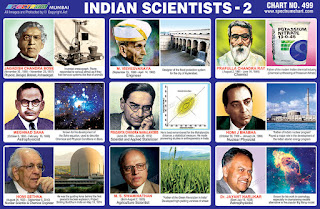 |
| Indian Scientists 2 Chart |
Spectrum Chart - 499 : Indian Scientists 2
1. Jagadish Chandra Bose (Physicist,
Biologist, Botanist, Archaeologist) - Jagadish Chandra Bose, was a
polymath, physicist, biologist, biophysicist, botanist and
archaeologist, as well as an early writer of science fiction. He also
invented the crescograph. He also pioneered the investigation of
radio and microwave optics, made very significant contributions to
plant science.
2. M. Visvesvaraya (Engineer) -
Mokshagundam Visvesvaraya was an Indian engineer, scholar, statesman
and the Diwan of Mysore from 1912 to 1918. He played a key role in
building of modern India. Visvesvaraya designed a flood protection
system for the city of Hyderabad. He supervised the construction of
the Krishna Raja Sagara Dam across the
Kaveri River from concept to it's inauguration. This dam created the
biggest reservoir in Asia when it was built. He was a recipient of
the Indian Republic's highest honour, the Bharat Ratna, in 1955.
3. Prafulla Chandra Ray (Chemist) –
Acharya Prafulla Chandra Ray was a Bengali chemist, educator and
entrepreneur. He was the founder of Bengal Chemicals &
Pharmaceuticals, India's first pharmaceutical company. In 1896, he
published a paper on preparation of a new stable chemical compound :
mercurous nitrite. This work made way for a large number of
investigative papers on nitrites and hyponitrites of different metals
and on nitrites of ammonia and organic amines.
4. Meghnad Saha (Astrophysicist) - Meghnad
Saha was an Indian astrophysicist best known for his development of
the Saha equation, used to describe chemical and physical conditions
in stars. Saha equation is one of the basic tools for interpretation
of the spectra of stars in astrophysics.
He also invented an instrument to
measure the weight and pressure of solar rays. Saha was also one of
the prominent among the works on Halley's Comet. Saha was the chief
architect of river planning in India and prepared the original plan
for the Damodar Valley Project.
5. Prasanta Chandra Mahalanobis (Scientist
& Applied Statistician) - Prasanta Chandra Mahalanobis was an
Indian scientist and applied statistician. He is best remembered for
the Mahalanobis distance, a statistical measure. He made pioneering
studies in anthropometry in India. Economic census, population
census, agricultural surveys and various other large scale and in
depth samples and surveys that have been admired world over for their
scope and accuracy owes its popularity and worldwide acceptance to
the grit, determination and genius of Prasanta Chandra Mahalanobis.
6. Homi J Bhabha (Nuclear Physicist) -
Homi Jehangir Bhabha was an Indian nuclear physicist, founding
director, and professor of physics at the Tata Institute of
Fundamental Research. Colloquially known as "father of the
Indian nuclear programme". Bhabha gained international
prominence after deriving a correct expression for the probability of
scattering positrons by electrons, a process now known as Bhabha
scattering. His major contribution included his work on Compton
scattering, R-process and furthermore the advancement of nuclear
physics.
7. Homi Sethna (Nuclear Scientist &
Chemical Engineer) - Homi Sethna was an Indian nuclear scientist and
a chemical engineer. He was the Chairman Atomic Energy
Commission(India) during the time when the first nuclear test range
Smiling Buddha in Pokhran Test Range in 1974 was conducted. He was
the primary and central figure in India's civilian nuclear program as
well as the construction of nuclear power plants.
8. M. S. Swaminathan (Agriculture
Scientist) - Mankombu Sambasivan Swaminathan is an Indian geneticist
and international administrator, renowned for his leading role in
India's Green Revolution a program under which high-yield varieties
of wheat and rice seedlings were planted in the fields of poor
farmers. Swaminathan is known as "Indian Father of Green
Revolution" for his leadership and success in introducing and
further developing high-yielding varieties of wheat in India.
9. Dr. Jayant Narlikar (Astrophysicist) -
Jayant Vishnu Narlikar is an Indian astrophysicist. Narlikar is a
proponent of steady state cosmology. He developed with Sir Fred Hoyle
the conformal gravity theory, commonly known as Hoyle–Narlikar
theory. It synthesises Albert Einstein's Theory of Relativity and
Mach's Principle. It proposes that the inertial mass of a particle is
a function of the masses of all other particles, multiplied by a
coupling constant, which is a function of cosmic epoch.

No comments:
Post a Comment